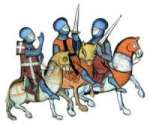 A Mini Guide to the Crusades
A Mini Guide to the Crusades
First Crusade: (1096-1102) ... Capture of Jerusalem July 15, 1099
Disastrous invasion of the Byzantine Empire: (1120-1125), (1128-1129), Second Crusade: (1139-1140)
Smaller crusades by Pope Calixtus II and Eugenius III (1114), (1118), (1122) and (1147), Spain (1187), (1177) to Palestine, etc.
Muslim victory at Hattin, loss of Jerusalem and Palestine to Saladin in (1187)
Third Crusade: (1189-1192) ... German Crusade: (1197-1198)
Children's Crusade: (1212), Crusade of the Shepherds (1251)
Forth Crusade: to Constantinople and Greece: (1217-1229)
Fifth Crusade: recovery of Jerusalem, (1239-1241), (1248-1254)
First crusade of King Louis IX of France inspired by the loss of Jerusalem, (1244)
Louis's second crusade: (1269-1272) and (1287-1290) Egypt (1278) and Tunisia (1270)
Other Crusades:
Spain (1187-1260), (1482-14902), Tripoli.
Livonia (1193-1230)
Prussia "perpetual Crusades by Teutonic Knights: (1245) - early in the 15th Century
Estonia Finland and Poland....(1199- on)
Crusades against political opponents of the Papacy in Italy (1255-1378)
Germany and Aragon, Flanders and Spain (1380s).
first Crusade against Heretics: Albigensian Crusade, France: (1209-1229)
Bosnia, Germany, Italy and Bohemia (1420-1431).
Greeks Crusades: (1231-1241)
Against Orthodox Russians: 13th Century
Against Protestant English: Armada of (1588)
Popular Crusades (1309-1320): Eastern Mediterranean, North Africa (1390),
Balkans (Crusades of Nicopolis....(1496).. Varna (1444), Belgrade (1456).
Alliance of interested powers in a crusade league: (1352)
Symrna (1344), Battle of Lepanto (1571), (1684), (1697), recovery of the Balkans.
North Africa: (1535), (1542), (1578)
Hospital of St. John still functioning in the late 16th C, though crusading was petering out, as a military order-state of Malta until that island fell to Napoleon in 1798.
"The crusading movement had involved every country in Europe, touching almost every area of life--the Church and religious thought, politics, the economy, and society--as well as generating its own literature. It had an enduing influence on the history of the western Islamic world and the Baltic region. Although until comparatively recently it tended to be thought of as something exotic and peripheral, it has never lacked historians.
Crusading is not easy to define. The movement lasted a very long time and opinions and policies changed. And it appealed at the same time to intellectuals and to the general public; so that we are faced by a range of ideas from the most cerebral to the most primitive, from the peaks of moral theology to the troughs of anti-Semitic blood feuds. ...
The prevailing interests used to be economic, proto-colonial, and military. now they are religious, legal, and social, and there is a growing emphasis on the origins and endurance of the impulses to crusade."
Source for information on this page----The Oxford Illustrated History of the Crusades.
